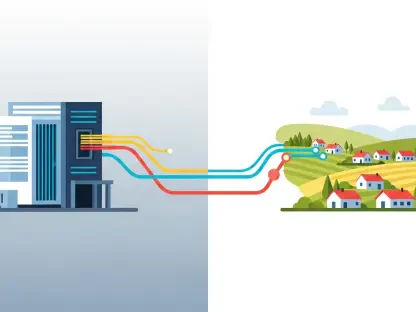In a nation where millions still lack reliable internet access, the Broadband Equity, Access, and Deployment (BEAD) program stands as a beacon of hope for achieving digital equity across the United States, aiming to transform connectivity in underserved regions. With the National Telecommunications and Information Administration (NTIA) approving proposals for 18 states and territories, the initiative is gaining traction, yet significant hurdles threaten to stall this ambitious effort as funds begin to roll out. This roundup gathers insights from state officials, broadband experts, and industry stakeholders to explore how the BEAD program is navigating deployment challenges and what strategies might ensure its success. The discussion delves into diverse perspectives on approvals, provider engagement, and bureaucratic barriers, shedding light on a critical moment for broadband expansion.
Decoding the BEAD Initiative: Voices on Digital Equity
The BEAD program, designed to expand internet access nationwide, has sparked optimism among state leaders and broadband advocates. Many emphasize its mission to close the digital divide, particularly in rural and low-income areas where connectivity remains a luxury. With Louisiana becoming the first state to access funding, stakeholders view this as a tangible step toward equity, highlighting the program’s potential to reshape lives through better access to education and economic opportunities.
However, not all voices share the same level of enthusiasm about the pace of progress. Some state officials point out that while 18 states and territories have secured NTIA approval, the unique nature of each proposal creates disparities in timelines. For instance, regions like Arizona and Nevada are on the cusp of funding but face distinct local challenges that could delay implementation, prompting a broader conversation about the need for tailored federal support.
A recurring theme among experts is the urgency of addressing systemic inequities in access. Industry leaders stress that without rapid deployment, the digital gap risks widening, especially for communities already left behind. This roundup aims to capture these varied viewpoints, offering a comprehensive look at how the BEAD program balances ambition with the realities of execution.
State Approvals and Funding: Diverse Perspectives on Milestones
Achievements and Disparities in State Progress
The approval of 18 states and territories by the NTIA marks a significant milestone for the BEAD program, with Louisiana leading as the first to tap into allocated funds. State broadband officials celebrate this achievement, noting that it sets a precedent for others to follow. Many express hope that this momentum will inspire faster action across remaining regions, aligning with the NTIA’s goal to distribute all funds by the end of the current year.
Contrasting opinions emerge when discussing states still awaiting clearance. Some administrators from states like Arizona and Nevada highlight that while they are close to securing funds, the individualized nature of proposals complicates uniform progress. A few officials argue that the NTIA’s evaluation criteria, though standardized, must adapt to regional nuances to prevent unnecessary delays in funding access.
Concerns also linger about additional hurdles, such as pending reviews from the National Institute of Standards and Technology (NIST), which are required before states can finalize ISP contracts. Certain state representatives question whether the year-end distribution target is feasible, urging federal agencies to prioritize expedited processes. These differing views underscore a tension between celebration and caution as the program advances.
ISP Engagement: Innovation Versus Capacity Concerns
The involvement of Internet Service Providers (ISPs) has been a focal point for many stakeholders, with states like Arizona reporting a notable surge in applications following updated NTIA guidance. Broadband directors in various regions praise this increase, attributing it to revised processes that encourage competitive bids and innovative technologies such as hybrid fiber-fixed wireless solutions. This trend is seen as a driver of creativity in addressing connectivity gaps.
On the other hand, some industry analysts raise questions about the capacity of smaller providers to meet deployment demands, especially in geographically challenging areas. They argue that while competition fosters innovation, it also risks overwhelming less-equipped ISPs, potentially leading to uneven service quality. This perspective calls for targeted support to ensure all providers can contribute effectively to the program’s goals.
A balanced view comes from state officials who acknowledge both the benefits and pitfalls of heightened ISP engagement. They suggest that while new players bring fresh ideas, federal and state collaboration must focus on leveling the playing field through clear guidelines and resources. This mix of optimism and concern shapes the ongoing dialogue about how ISPs fit into the broader BEAD framework.
Permitting Challenges: A Barrier Drawing Mixed Reactions
Permitting issues stand out as a critical obstacle in broadband deployment, with many stakeholders identifying local, state, and federal regulations as major delays. Officials from states with significant federally owned land, such as Nevada, describe the added complexity of navigating multiple jurisdictional requirements. This sentiment resonates across regions where infrastructure projects face prolonged approval times due to regulatory overlap.
Differing opinions surface on how to tackle these challenges, with some broadband experts advocating for streamlined permitting at the federal level to override local bottlenecks. They argue that without centralized coordination, deployment timelines will continue to stretch, undermining the BEAD program’s objectives. This perspective often cites the lack of clear information on required permits as a root cause of frustration for providers.
Meanwhile, other voices emphasize the importance of respecting local authority in land management, suggesting that better communication—rather than top-down mandates—could resolve conflicts. They propose creating shared databases or standardized checklists to clarify permitting needs, a solution seen as practical by several state planners. These contrasting approaches highlight the multifaceted nature of this roadblock in the rollout process.
Bureaucratic Hurdles: Opinions on Streamlining Operations
Beyond permitting, broader bureaucratic challenges draw significant attention from BEAD program observers. Many state leaders express cautious optimism about federal promises to expedite NIST reviews, viewing these as essential for unlocking funds and initiating contracts. They believe that faster administrative action could be the key to maintaining deployment momentum across diverse regions.
However, some industry commentators warn that logistical delays and systemic red tape remain formidable threats, even with accelerated reviews. They point to disparities between states with efficient administrative systems and those bogged down by outdated processes, suggesting that federal-state partnerships must address these gaps. This critical stance calls for a reevaluation of current mechanisms to prevent bottlenecks from derailing progress.
A third perspective focuses on long-term policy adjustments, with certain experts urging the adoption of permanent streamlined frameworks beyond temporary fixes. They argue that sustainable collaboration between federal and state entities will be crucial for future broadband initiatives, ensuring lessons learned from BEAD inform better practices. This forward-thinking approach adds depth to the discussion on overcoming administrative obstacles.
Strategies and Insights for BEAD Program Success
Stakeholders across the board agree that the BEAD program’s journey reflects a dual narrative of notable progress and persistent challenges. State approvals and increased ISP participation signal forward movement, yet permitting issues and bureaucratic delays cast shadows over timelines. Many broadband officials stress the need for practical strategies, such as enhanced federal-local coordination on regulatory approvals, to keep deployment on track.
Another widely discussed solution involves transparent guidelines for ISPs, ensuring both large and small providers can navigate the complexities of the program. Industry voices also advocate for dedicated task forces to address information-sharing gaps in permitting, a step seen as vital for minimizing misunderstandings. These actionable ideas aim to bridge the divide between ambition and reality in broadband expansion.
For communities eager to see results, staying informed about state-specific BEAD plans and advocating for local policy changes can amplify impact. Engaging with regional broadband offices or participating in public forums offers a way to push for faster implementation. This shared responsibility underscores the collective effort required to transform connectivity and achieve equitable access nationwide.
Reflecting on the Path Forward for Broadband Expansion
Looking back, the roundup of perspectives on the BEAD program reveals a landscape of hope tempered by pragmatic concerns, as state officials, industry experts, and broadband advocates weigh in on its trajectory. The insights gathered paint a picture of significant strides in approvals and provider engagement, juxtaposed against the stubborn barriers of permitting and bureaucracy. Each viewpoint contributes to a richer understanding of what it takes to move the needle on digital equity.
Moving forward, the focus should shift to actionable collaboration, with federal and state entities doubling down on innovative permitting solutions and streamlined funding processes. Establishing pilot programs to test new administrative models could offer valuable data for scaling success. Additionally, empowering communities through accessible resources and advocacy tools will be essential to sustain momentum and ensure no region is left behind in this critical endeavor.









